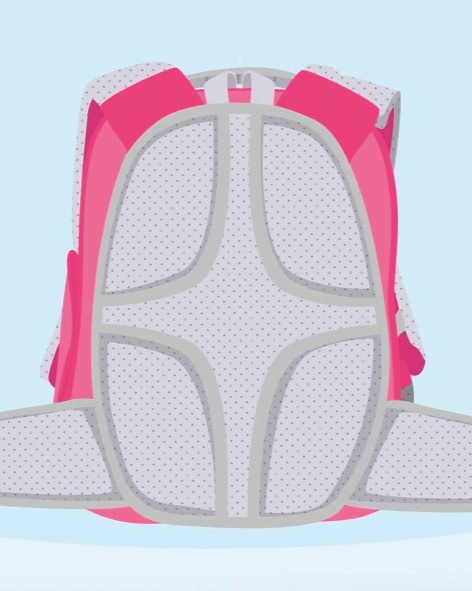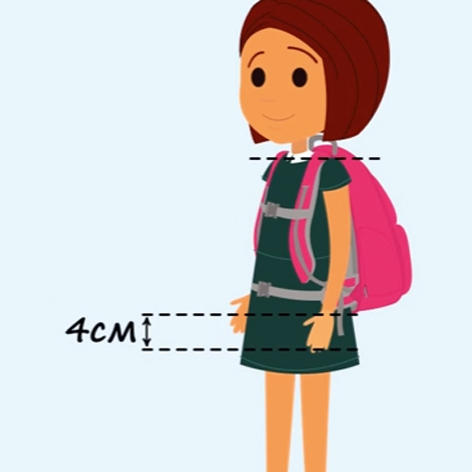Which backpack should you choose so you can wear it comfortably and avoid back pain? With so many models to choose from, it's easy to get lost, which is why Kite has developed rules for choosing the perfect one. Here are 8 rules to help you choose the right backpack.
 This is the first thing parents look for when buying a backpack. The anatomical backrest follows the natural curvature of the spine and reduces strain on the back, especially during prolonged wear. It keeps your back in a natural position, and teaches you not to slouch or arch your shoulders. Each Kite orthopaedic backpack is manufactured with an anatomical backrest.
This is the first thing parents look for when buying a backpack. The anatomical backrest follows the natural curvature of the spine and reduces strain on the back, especially during prolonged wear. It keeps your back in a natural position, and teaches you not to slouch or arch your shoulders. Each Kite orthopaedic backpack is manufactured with an anatomical backrest.
 Ensure tight fit of the backpack on the shoulders, do not put pressure on the shoulders, do not chafe against the neck. Distance between shoulder straps in the place where they are attached to the backpack must be 4 cm, width of shoulder straps – not less than 5,5 cm.
Ensure tight fit of the backpack on the shoulders, do not put pressure on the shoulders, do not chafe against the neck. Distance between shoulder straps in the place where they are attached to the backpack must be 4 cm, width of shoulder straps – not less than 5,5 cm.
 It is important that the backpack for primary school contains these elements. The straps fix the backpack firmly to the body and prevent it from wobbling from side to side during movement. They help distribute the load evenly over all parts of the spine.
It is important that the backpack for primary school contains these elements. The straps fix the backpack firmly to the body and prevent it from wobbling from side to side during movement. They help distribute the load evenly over all parts of the spine.
 Due to different body shapes and heights, it's impossible to design a backpack with universal parameters for everyone. So when fitting, remember to keep the bottom of the backpack 4 cm below your waist and the top edge at shoulder height. The shoulder straps will help the backpack fit perfectly. Pay attention to the size of the product shown on the label. It should be matched to your child's height. The weight of an empty rucksack should be max. 1 kg, and the weight of a full rucksack should be max. 10 % of your child's body weight.
Due to different body shapes and heights, it's impossible to design a backpack with universal parameters for everyone. So when fitting, remember to keep the bottom of the backpack 4 cm below your waist and the top edge at shoulder height. The shoulder straps will help the backpack fit perfectly. Pay attention to the size of the product shown on the label. It should be matched to your child's height. The weight of an empty rucksack should be max. 1 kg, and the weight of a full rucksack should be max. 10 % of your child's body weight.
 Firmly hold textbooks, maintain body balance during movement. It is advisable to place heavier textbooks closer to the back.
Firmly hold textbooks, maintain body balance during movement. It is advisable to place heavier textbooks closer to the back.
 Protect the child on the road during hours of darkness. A special coating on the elements reflects light from car headlights and streetlights.
Protect the child on the road during hours of darkness. A special coating on the elements reflects light from car headlights and streetlights.
 Use both shoulder straps with chest strap fastened. Carrying the backpack on one of nerve endlings and vessels, compression of vertebrae and development of scoliosis.
Use both shoulder straps with chest strap fastened. Carrying the backpack on one of nerve endlings and vessels, compression of vertebrae and development of scoliosis.
 A packed backpack weighs 1kg or more, so train your child to put on and take off the packed backpack from a high surface. This puts the weight evenly on the shoulders and distributes it over the back. If there is no suitable surface nearby, use an alternative method. Lift the backpack by the top handle at knee height, place it on your thigh and slide your arms into the shoulder straps one at a time.
A packed backpack weighs 1kg or more, so train your child to put on and take off the packed backpack from a high surface. This puts the weight evenly on the shoulders and distributes it over the back. If there is no suitable surface nearby, use an alternative method. Lift the backpack by the top handle at knee height, place it on your thigh and slide your arms into the shoulder straps one at a time.
For your convenience, all the information is presented on a single leaflet. Print it out and use it as a guide when choosing a backpack for your child.
